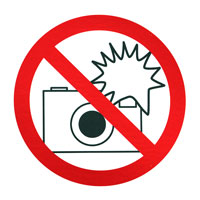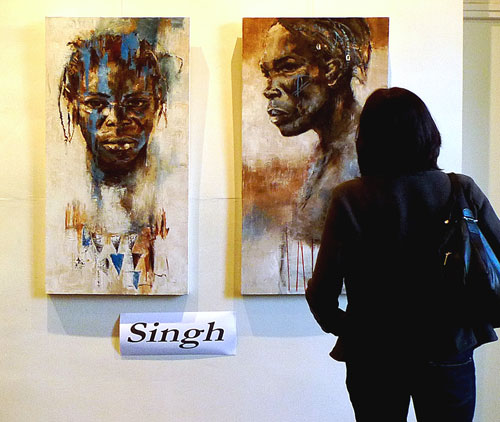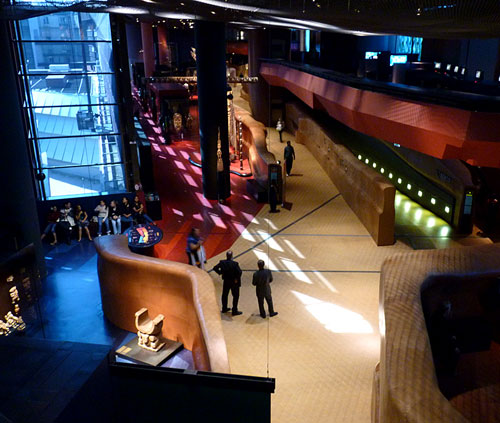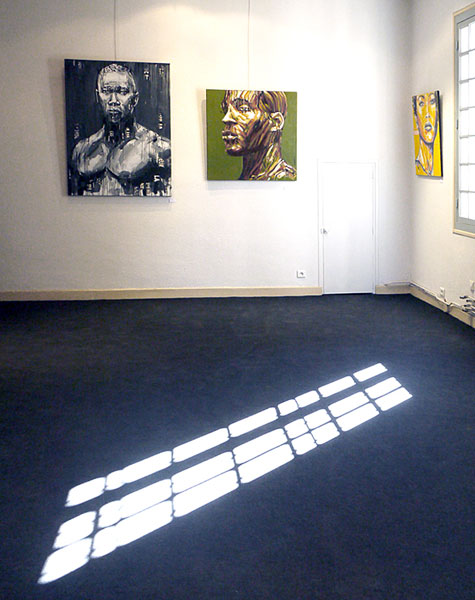 |  |
Does flash photography really damage art? The persistence of a myth.
 The other day, I went to an exhibition of photographs by W. Eugene Smith. Entering the museum, I spotted a sign that said, “No Flash Photography!” Out of curiosity, I walked over to a museum guard and asked him why flash photography was prohibited.
The other day, I went to an exhibition of photographs by W. Eugene Smith. Entering the museum, I spotted a sign that said, “No Flash Photography!” Out of curiosity, I walked over to a museum guard and asked him why flash photography was prohibited.
His response was "le froid de la lumière est mauvaise pour l'art" - "the cold from the flash is bad for the art." Cold from the flash? Say what?
At first, I laughed. Was this some weird Jedi mind trick?
Curious about this, I began to look into photography bans and found that while the guard's idea was bizarre, it was no crazier than some of the other "reasons" for photography bans, and apparently wasn't even a one-off aberration: In the work by Evans (linked below), he reports "A friend of mine was once admonished by a museum attendant, who said that the light was so bright that it could freeze an object, and this sudden cold shock would be damaging to a delicate wooden exhibit!" Apparently, the idea of a flash "freezing" motion has translated into a meme among museum staff of flash "freezing" objects.
I myself rarely use flash, especially the little ones built into my cameras. I prefer to use existing light as I did in the pictures with this post. Nonetheless, we have all seen the signs prohibiting photography and especially flash photography.
Nonetheless, we have all seen the signs prohibiting photography and especially flash photography.
It seemed strange to me that so many museums, galleries and businesses prohibit photography. Especially now, when it seems that everyone has an iPhone or digital camera with them at all times.
I wondered why there are “no shoot” zones.
Can flash photography harm art?
First, let me deal with the basic question raised by the sign and the guard’s response. Can flashes harm art? If, as I suspected, they did not, why was flash photography and photography in general banned in so many places? Where did this idea come from?
I wondered why there are “no shoot” zones.
Can flash photography harm art?
First, let me deal with the basic question raised by the sign and the guard’s response. Can flashes harm art? If, as I suspected, they did not, why was flash photography and photography in general banned in so many places? Where did this idea come from?
I began to search for answers and came across an article: “Amateur Photographers in Art Galleries: Assessing the harm done by flash photography” by Martin H. Evans.
It began with Evans pointing out that, “For several decades it has been widely believed that the intense illumination from photographic flashguns will damage delicate art and documents.”
It began with Evans pointing out that, “For several decades it has been widely believed that the intense illumination from photographic flashguns will damage delicate art and documents.”

What keeps this idea going he says is that, “The brightness of the peak intensity of the flash and uncertainty about ultraviolet (UV) energy frightened curators, and soon there was general agreement that use of these electronic flashguns should not be permitted in museums and fine art galleries.”
To find the basis for this belief, he reviewed the literature and discovered an experiment carried out by the National Gallery (London) in 1995. It “demonstrated” that repeated flashes could change the colors in test pigments. This study became one of the primary justifications for photo bans. Yet, when Evans looked at the data, he saw something entirely different.
In the experiment, two powerful “potato masher” electronic flashes were used. The experimenters removed the UV blocking glass filter from one of the flashes to get the maximum UV output. They placed each flash about three feet from panels of colored pigments and dyed fabrics. A similar panel was set up under “standard gallery lighting” as a control. Over the next few months, the flashes were fired every seven seconds.
After more than a million flashes, the pigments and dyes exposed to the naked flash showed a slight, but visible, fading in a few samples. The samples exposed to the glass filtered flash showed no visible change, although the experimenters were able to detect very small changes with a densitometer. Interestingly, the change for the control group was the same as for the filtered flash. However, seeing any pigment change was enough for the National Gallery to state that they had shown that flash was dangerous.
Evans took this idea apart.
“In the vast majority of pigments there was no more change from UV-filtered flash than from the same quantity of gallery lighting (the control). When there was no UV filter the change was about 10-15% greater than from the equivalent quantity of gallery light.”
“In practice almost all small camera-mounted (and built-in) flashes… incorporate …filters that remove most of the UV wavelengths which conservators fear.”
They talked themselves into it
Evans pointed out that damage to artwork, depends, not just on flash intensity, but duration. In the experiment, the million flashes were from large strobes mounted close to the pigments. In the real world, tiny on-board flashes, fired from a dozen feet away from work, would have to be fired billions of times to get even the same slight effect. If the problem was not the flash then what was going on?
Martin Evans puts it simply: “Curators, journalists, art-lovers and museum directors have been telling each other this (that flashes damage art) for years, and many gallery visitors concur.”

In other words, they’ve talked themselves into a belief, based on talking to themselves about their belief. Evans points out the irony that, "Curators ban photographing things like Pharaonic Egyptian relics that have been bathed in the intense UV light of desert sunlight for over 3000 years.”
Another reason given for the prohibition is the concern for copyright violation. However as Martin Evans points out: “Copyright laws vary from one country to another, and are notoriously difficult to interpret. In some cases, a museum or art gallery might be using the copyright argument as a smokescreen to hide a general desire to prevent visitors from taking photographs.”
Other reasons
What then are the reasons for prohibiting all photography and flash photography in particular?
One reason, told to photographer Paul Harcourt Davies by a museum guard, was that photography was banned to keep crowds moving. At a popular exhibit, people wait on line for hours and any photography slows down the line. Fewer people can get in to see the exhibit and revenue is lost.
There is another very real reason to ban photography: gift shop sales. Most museums make a substantial amount of their revenue from the sale of postcards, posters and other bric-a-brac. The fear is that people taking their own photos, no matter how badly, are going to spend less at a gift shop.
There is another very real reason to ban photography: gift shop sales. Most museums make a substantial amount of their revenue from the sale of postcards, posters and other bric-a-brac. The fear is that people taking their own photos, no matter how badly, are going to spend less at a gift shop.
The terrorist theory
Of course, there’s another argument for a photography ban that we hear a lot about these days: the terrorist theory.
Of course, there’s another argument for a photography ban that we hear a lot about these days: the terrorist theory.
Shopping malls, galleries, and museums express concern about security issues ranging from international terrorism to plain old vanilla criminal theft. Sounds like they've been watching too many Hollywood caper movies.
Why would a terrorist need to take photos in a museum or shopping mall when these venues are more than happy to give away detailed brochures -- with maps -- for free? These publications provide more information than any malefactor could record with a camera.
From Martin Evans' perspective, the good news is that flash photography does not hurt artwork. What remains is the bad news that despite the science, galleries and museums believe what they believe and continue the bans.

×Comments for this thread are now closed.
No comments:
Post a Comment